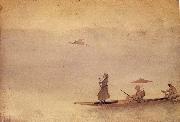Wholesale Oil Painting No Minimum |
|||||||||||
|
|
|||||||||||

|
|||||||||||
|
|
|
||||||||
Abanindranath TagoreIndian, 1871-1951,Painter and writer, brother of Gaganendranath Tagore. Intermittently taught by two undistinguished European academicians, Olinto Ghilardy and Charles Palmer, in 1897 he came under the influence of Ernest Binfield Havell (see HAVELL,), art scholar and catalyst of indigenism. Impressed by Mughal and Persian miniatures and the work of the Japanese artists Taikan Yokoyama and Shunso Hishida, who visited India in 1903, Abanindranath discarded Western realism for the stylized naturalism of Japanese art, which suited his poetic temperament, and the general John Ruskin-William Morris thought axis of such early indigenist theorists as Havell and Ananda Kentish Coomaraswamy. His work until the Omar Khayyam illustrations (1906-10; Santiniketan, Nandan Mus.), with their revivalist nationalism and fin-de-siecle affectations, greatly influenced the Neo-Bengal art movement formed chiefly by his pupils at the Calcutta Art School, where he was Vice-principal from 1905 to 1915. His own later work developed an imagist focus. The Arabian Nights series (1930; Calcutta, Babindra-Bharati Soc.), his magnum opus, in which literary and visual antecedents give the image a cultural ambience without intruding on its independence, marks the beginning of modern Indian narrative painting. His aesthetic theories, formulated in lectures he gave as the Vageswari Professor of Art at Calcutta University (1921-9), stressed the role of individual sensibility and imagination in creativity. Induced by his uncle Rabindranath, |
||||||||
|
|
||||||||
Hunting on the Wular
Hunting on the Wular Painting ID:: 39864 |
mk153
Wash and Watercolor on paper
mk153 Wash and Watercolor on paper |
|||||||
|
CONTACT US |

